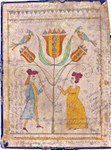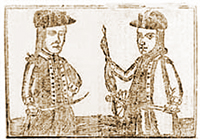 |
||||||||||||||||
An American Family History |
||||||||||||||||
Leonard Kenoyer & Anna Barbara Buck |
||||||||||||||||
North Codorus Township, York County, Pennsylvania |
||||||||||||||||
|
“Remember, remember always, that all of us, and you and I especially, are descended from immigrants and revolutionists."
— Franklin D. Roosevelt |
||||||||||||||||
|
||||||||||||||||

|
Leonhardt (Leonard) Kenoyer was born about 1725 in Germany. He (Gnarr) sailed on the ship Anderson from Rotterdam, Holland, to Portsmouth, England, to Philadelphia arriving on September 27, 1752. The ship's captain was Hugh Campbell. In 1752 a Leonhardt Gnarr was on the tax list of Philadelphia County, Pennsylvania. He married Anna Barbara about 1753. Barbara Kenoyer Kessler was born about 1754. According to the Evangelical Lutheran minister, the Reverend John Casper Stoever's records, Leonard and Barbara were sponsors when Maria Barbara daughter of David Dreher of Lebanon was baptized on January 25, 1756. Johann Ulrich Kenoyer was born about 1758. Leonard Kenoyer was born about 1759. He was baptized on June 22, 1759 in York County, Pennsylvania. by the Reverend Schlegel at Daniel Wotring's (Vautrin) meeting room. Leonard's sponsors were Melchior Schmidt, Adam Hoff, Christopher Haller, and Peter Pinckele. In 1759 they received a warrant for 150 acres in Codorus and Manheim Townships where they had been living. They called it Kneier's Valley. Their land was adjacent to the church lands of St. Jacob's Old Stone Church. In 1762 Leonard was in the Codorus Township tax list. Catharine Elizabeth Kenoyer Clouse was born about 1761 and baptized in June, 1762 by the traveling minister, Reverend Jacob Lischy. Her sponsors were Frederich and Catharina Röhmer. Frederick Kenoyer was born about 1765. Christian Kenoyer was born on January 1, 1766 He was baptized on April 6, 1766 the first Sunday after Easter at St. Jacob's. Anna Maria Kenoyer was born about 1767. In March, 1770 Leonard and Barbara were sponsors for Johann Frederick Schuss and in November, 1770 they were sponsors for Anna Barbara Ungerer at St. Jacob's. On November 3, 1774 130.91 acres were surveyed for Leonard Kenoyer and given the name of "Kneier's Valley." The survey map shows a house and a large barn. The family was active in the Revolution. Leonard and Ulrich were in Captain George Hoover's Company. In March, 1778 Leonard and Barbara were sponsors for their grandson, Simon Kessler, the son of Henry and Barbara Kessler at Zeigler's (St. Pauls) Lutheran Church in Codorus. In 1779 Leonard Kenoyer owned 60 acres, 2 horses, and head of 3 cattle and was taxed £12.10.0. In May, 1780 Leonhard Kenoyer and wife, Barbara, were sponsors for granddaughter, Barbara Kessler Beary, daughter of Barbara and Henry Kessler, at Zeigler's. In 1780 Leonard owned 50 acres, 2 horses, and 3 cattle. He was taxed £10. In 1781 he owned 45 acres, 2 horses, and 2 cattle. He was taxed £1.10.6. In 1782 he owned 100 acres, 2 horses and 2 cattle. He was taxed £2.19.3. In 1782 Leonard died intestate. His funeral was conducted by the Reverend John Daniel Shrödter. The "Inventory of the goods and effects of the late Leonard Kenoyer, Dec. of Codorus Township" was filed on April 14, 1783. The value of the estate came to £81.19.3. Four items were added valued at £4.8.6. The document was signed by Barbara Kenoyer (her X mark) and Ulrich Kneier. The inventory included:
George Dehoff, who appraised the estate, was paid £0.14.10. George Wehrly, was paid £4.6.3 for making Leonard's coffin and for appraising and writing the list of auction items and the advertisement for the auction. The Reverend John Daniel Shrödter was paid £0.15.10 for the religious service. Christopher Shroth, the auctioneer. was paid £3.15.10 for "crying the vendus." Henry Ponsler owed Leonard £4. On June 3, 1783 the court named Captain John Wampler of Manheim Township as the guardian of Frederick age 17 and Mary age 15. The eldest, Ulrich Kenoyer was named
The estate appraised at about £104. In 1783 Anna Barbara Kenoyer owned 100 acres, two houses, and one outhouse, valued at £65. She was taxed £1.7.1. There were three members of the household. The first of the great floods of the Codorus was in March, 1784. It is called the "Ice Flood" and the water and ice rose to extraordinary heights and did considerable damage. In 1785 Sheriff Henry Miller appraised 130 acres in Kneier's Valley at £135 and granted it to Ulrich Kenoyer. The value was set at £135. In 1785, Frederick was in the York County, Pennsylvania militia. He was in 7th Company in the 7th Battalion under Captain John Wampler, his former guardian. Another great flood was in October, 1786. This flood destroyed every bridge on the Codorus.
|
|
||||||||||||||
|
||||||||||||||||
|
©Roberta Tuller 2023
|
||||||||||||||||



